Timeless Kitchen and Bath Designs for Modern Homes
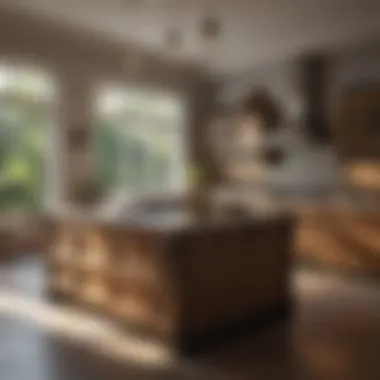
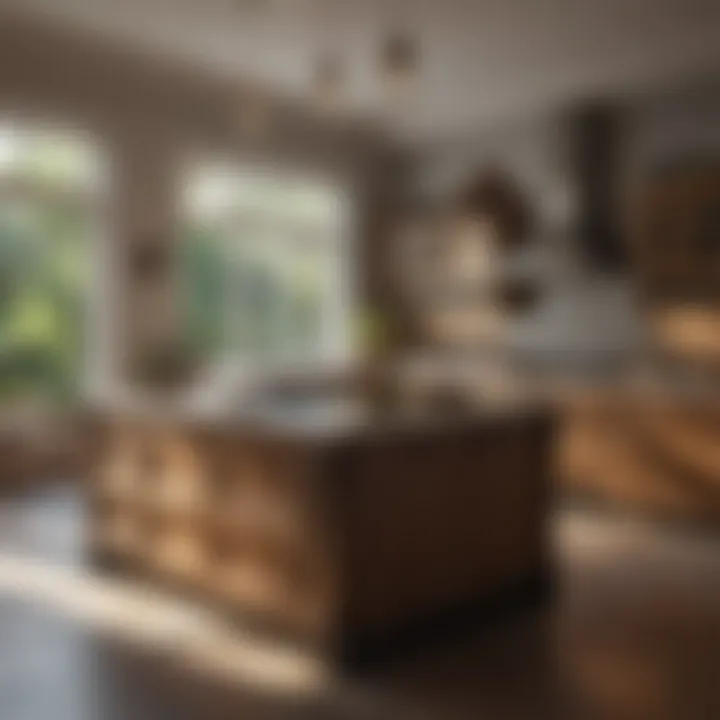
Intro
In the world of home design, kitchens and bathrooms stand out as two of the most important spaces. They're both functional areas where daily activities happen, yet they also define the overall character of a home. When creating a space that is not only useful but also visually appealing, a timeless approach to design is essential. This article delves deep into the concepts that contribute to the lasting allure of kitchen and bath design, merging practical need with elegant style.
With careful thought on material choices, color schemes, and space optimization, homeowners can achieve environments that are both soothing and stylish. This guide sheds light on must-know trends, tips for achieving sustainability, and various design inspirations that echo the best of both worlds, ensuring that kitchens and bathrooms remain eternally inviting and functional.
Design Inspirations
When it comes to kitchen and bath designs, inspiration can strike from various places. Each home has its own story, and the design elements you choose tell that story. Below, we explore the contrasts and harmonies found in modern and traditional styles, as well as the significance of color and texture.
Modern vs. Traditional Bath and Bedroom Styles
The debate between modern and traditional styles often boils down to personal preference, though each carries its unique appeal.
- Modern designs tend to feature sleek lines, open spaces, and minimalist aesthetics. These kitchens and bathrooms often include high-tech fixtures and materials like stainless steel, glass, and polished stone. Built-in storage solutions are common, maximizing space while keeping clutter out of sight.
- Traditional styles, on the other hand, evoke a sense of warmth and nostalgia. Rich woods, ornamental fixtures, and classic finishes characterize these spaces. Think of a clawfoot bathtub or an intricately designed vanity, which can bring a touch of historical elegance to the bathroom.
A perfect balance can often be found in transitional styles, which blend elements of both modern and traditional designs, allowing each homeowner to create a unique space that suits their personality.
Color Palettes and Textures
The colors and textures chosen for kitchens and bathrooms can drastically alter the atmosphere of these areas. Neutral tones often serve as the backdrop, allowing homeowners to introduce splashes of color through accessories or accent walls. Here are a few effective strategies:
- Earthy and natural tones such as taupes, browns, and muted greens can bring a calming vibe, reflecting elements found in nature.
- Bold colors—think deep navy or vibrant teal—work wonders when used sparingly, perhaps as an accent in a backsplash or within cabinet choices.
- Textures, whether it’s the smoothness of quartz countertops or the warmth of reclaimed wood, add depth and interest.
Remember, the marriage of color and texture can animate spaces in fantastic ways, making them feel genuinely alive. The interplay between soft textiles, metallic finishes, and glossy surfaces can elevate any kitchen or bathroom from ordinary to extraordinary.
"A well-designed kitchen and bath can transform not only a home, but also the everyday experiences within it."
Learning how to blend these elements effectively can lead to a design that feels both current and enduring. After establishing a clear vision with these inspirations, homeowners can begin focusing on the actual products and fixtures that will bring them to life.
Product Reviews
The actual selection of products can make or break your space. Choosing the right fixtures and materials is where design really comes into play. Let's dive into optimal selections for baths and kitchens.
Bathtubs and Showers
When considering bathtubs and showers, it’s essential to strike a balance between functionality and style. Some options to think about include:
- Freestanding tubs, which offer a stunning focal point and are suitable for spacious bathrooms.
- Walk-in showers, increasingly popular for their ease of access and sleek appearance.
- Combination units, which are practical for smaller spaces while providing both shower and bath options.
Vanity and Sink Options
Picking the right vanity and sink is crucial for maximizing space and aesthetics. Common varieties include:
- Floating vanities that provide the illusion of more space and are stylishly contemporary.
- Double sinks, great for busy households, permitting simultaneous use.
- Under-mounted sinks, which create seamless connections with the countertop, simplifying cleaning obligations.
By thoughtfully considering these elements, homeowners will find themselves well on their way to achieving a harmonious blend of style and practicality within their kitchens and bathrooms.
Understanding Timeless Design
In the realm of home renovations, the concept of timeless design holds considerable significance. As homeowners embark on the journey to update their kitchens and baths, the balance of beauty and usability can be quite a daunting task. Timeless design is about creating spaces that not only capture the aesthetic essence of today but also transcend fleeting trends. This article aims to unravel the intricate layers of what constitutes timelessness in kitchen and bath design, rooting for practical considerations that resonate with modern homeowners.
Defining Timelessness in Design
When we talk about timelessness, it's worth dissecting what people really mean. Often, it conjures images of classic elements—think Victorian elegance or the clean lines of mid-century modern. Buttimelessness is more than mere aesthetics; it embodies adaptability and enduring appeal. A timeless kitchen or bath needs to communicate warmth and functionality, ensuring that the design serves its purpose efficiently while remaining visually pleasing.
Timelessness often springs from the combination of thoughtful architecture, quality materials, and an intuitive layout. Choices such as sleek cabinetry, plush countertops, and effective storage solutions embody these principles. Homeowners will find that opting for versatile designs allows spaces to shift and evolve, accommodating changing family needs without losing their core charm.
Historical Perspectives on Kitchen and Bath Design
Looking back through the annals of design history, kitchens and baths have seen a dramatic evolution. From the rudimentary cooking areas of early civilizations to the sophisticated spaces we enjoy now, each era has imprinted its unique signature upon these rooms. The early 20th century welcomed indoor plumbing and gas-powered stoves, forever changing the landscape of home cooking and bathing. Fast forward to today, where elements like smart technology are not just an advantage but an essential aspect.
A notable benchmark was the post-war era, which offered an explosion of consumer goods. It was during this time that designers began emphasizing the kitchen as the heart of the home, emphasizing open layouts that promote inclusivity. Such historical perspectives inform contemporary choices, marrying tradition with modern standards, resulting in cohesive design across the home.
The Importance of Functionality and Aesthetics
Finding that sweet spot between form and function is crucial in timeless design. After all, a beautifully designed kitchen will quickly lose its charm if it doesn't serve its intended purpose. Functionality refers to ensuring that all elements are not just pleasing to the eye but work effectively together. This includes maximizing space through smart storage options and ensuring efficient workflow within the kitchen layout.
Simultaneously, we cannot overlook aesthetics. A space that feels inviting and cohesive makes daily activities enjoyable. This blend of practical design elements alongside visually appealing materials, like stunning quartz countertops or natural wood, contributes to a home that feels both livable and luxurious.
"Timeless design is not just an aesthetic choice; it’s about creating a sense of harmony in the home that facilitates life’s rhythm."
In summary, understanding timeless design is pivotal for anyone considering a kitchen or bathroom renovation. It encourages a conscious approach, blending historical context, functionality, and aesthetics to create spaces that stand the test of time. Striking the right balance paves the way not just for a visually appealing environment but also makes daily life easier and more enjoyable.
Key Elements of Timeless Kitchens
When we talk about kitchens that stand the test of time, it’s not just about picking a style that doesn’t go out of fashion. It’s also about marrying function with form, ensuring that every part of the kitchen is both beautiful and practical. Timeless kitchens are ultimately those spaces that can adapt, evolve, and still resonate with the changing tastes of homeowners, all while remaining fundamentally useful. In this section, we dive deep into what makes a kitchen endure through generations.
Material Choices for Longevity
Wood
Wood often gets the spotlight when discussing kitchen materials. Its charm lies in its warmth and versatility, making it an evergreen choice for cabinetry and countertops. What sets wood apart is its unique grain and finish, allowing it to meld seamlessly with various styles—from rustic to modern. One notable feature of wood is its ability to age gracefully; it develops a patina over time, enhancing its character. However, wood also needs some tender loving care; it can be prone to scratches and water damage if not properly maintained.
Stone
Stone, such as granite and quartz, brings an inherently robust quality to kitchens, signalling durability. The key characteristic of stone surfaces is their resistance to heat and scratches, which is vital in a busy kitchen. Not only does stone offer practicality, but its unique patterns bring sophistication. However, stone can be heavy and may require professional installation, as well as periodic sealing depending on the type of stone used.
Metals
Incorporating metals—especially stainless steel—adds a sleek, modern touch to kitchens. This choice stands out for its resilience against heat and moisture, which is crucial for kitchen environments. Stainless steel appliances and fixtures are also relatively easy to clean, maintaining a polished look over time. However, fingerprints and smudges can be particularly noticeable on metal surfaces, necessitating regular upkeep to keep up its appealing shine.
Color Palettes that Endure
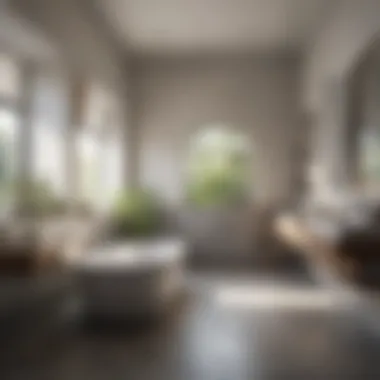
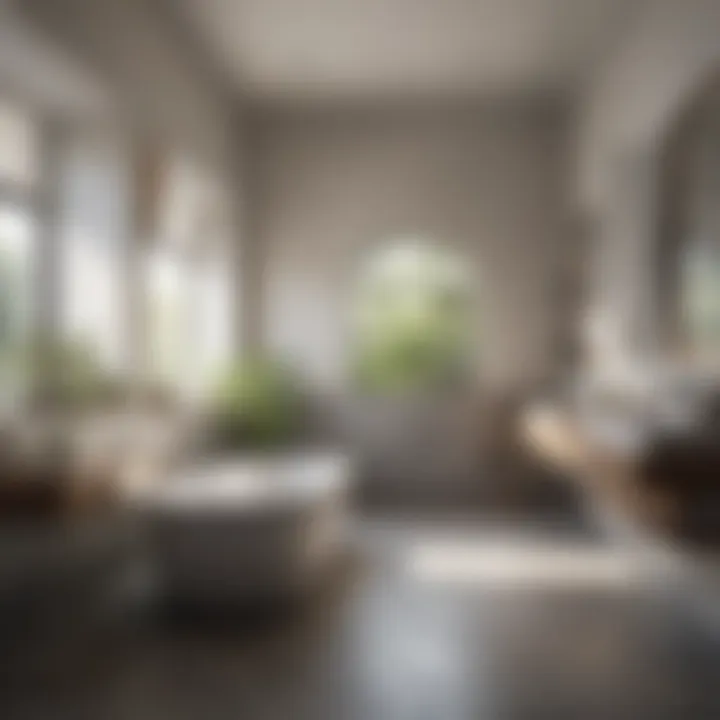
Neutral Tones
Neutral tones are the backbone of timeless kitchen designs. They provide a blank canvas, allowing homeowners to experiment with textures and accessories without clashing. Shades like beige, gray, or white can make a kitchen feel open and inviting. The unique aspect of neutrals is their ability to adapt, providing a timelessness that can feel fresh with just the addition of colorful accents. However, it’s essential to balance these hues with warmth, or the space may feel too sterile.
Classic Combinations
Classic color combinations, such as navy blue and white or black and cream, are perennially appealing. They offer depth while staying true to the essence of a timeless kitchen. A notable feature of these combos is their ability to create contrast without overwhelming the senses. While their aesthetic appeal is undeniable, using too bold a palette can date a kitchen, so it's wise to keep things balanced.
Accent Colors
Accent colors add flair to timeless kitchens, often emerging through back splashes or decorative items. They provide a pop that can lift the mood of a space. A well-placed splash of color—perhaps a vibrant red or soft sage green—can create visual interest without overwhelming the main design elements. Care needs to be taken, though; an overuse of bright hues can make the kitchen feel chaotic rather than harmonious.
Layout and Space Optimization
The Work Triangle
The work triangle concept is a foundational layout principle in kitchen design, involving the arrangement of the stove, sink, and refrigerator. This time-tested layout optimizes functionality, allowing chefs to move seamlessly between cooking tasks. Maintaining an effective work triangle means your kitchen will always be user-friendly, regardless of aesthetic changes. A drawback can stem from an improperly designed triangle, which can lead to unnecessary steps while working.
Open Floor Plans
Open floor plans have become immensely popular as they foster a sense of community and family engagement. By removing barriers between the kitchen and adjacent spaces, this layout encourages social interaction during meal prep. However, it's essential to ensure proper zoning to maintain that warm, inviting feel—otherwise, the kitchen might feel like an afterthought in the overall design.
Storage Solutions
Good storage solutions are invaluable in a timeless kitchen. Efficient use of vertical space, such as open shelving or built-in cabinets, maximizes storage while keeping the kitchen uncluttered. This practicality, combined with aesthetic storage solutions, keeps essentials close at hand yet out of sight. Still, too much visible storage can create a visual overload, so it’s wise to balance practicality with elegance.
Timeless Features in Bathroom Design
In the realm of kitchen and bath design, the bathroom often takes center stage when it comes to achieving a timeless appeal. Many homeowners consider this space not just functional but an oasis of relaxation. The selection of specific elements can greatly influence the overall atmosphere, functionality, and aesthetic of a bath. In this section, we will delve into the timeless features that can uplift the bathroom into a realm of enduring elegance while blending seamlessly with modern needs.
Selecting Bathtubs and Showers
Freestanding Tubs
A freestanding tub often steals the spotlight in many bathroom designs. The allure of these tubs lies in their ability to stand alone, making them a striking focal point in any bathroom. Often crafted from materials such as acrylic, cast iron, or stone, these tubs not only bring beauty but also comfort. The unique feature of a freestanding tub is its availability in various shapes and sizes, ranging from modern to vintage styles, allowing homeowners to select one that aligns perfectly with their design vision.
However, while these tubs offer aesthetic appeal, they do require a bit more cleaning due to their exposed surfaces. If you desire a luxurious soak at the end of a long day, they are indeed a popular choice.
Walk-in Showers
Walk-in showers add a layer of convenience and elegance that is hard to match. The open concept of walk-in showers creates a spacious feel in bathrooms of all sizes. By eliminating the need for a traditional shower door, they enhance accessibility while reducing barriers – an important consideration for multi-generational homes.
Their unique feature is the wide range of design options available; from sleek glass panels to custom tiling, every inch can be tailored to the homeowner's tastes. Those wanting efficient water flow should consider investing in high-quality showerheads. However, some may find that a walk-in shower lacks the closure provided by a traditional setup, which can lead to increased water splashing on the floors.
Hydrotherapy Options
Hydrotherapy options in bathing spaces are gaining momentum, offering therapeutic benefits that stretch beyond mere aesthetics. Not only can hydrotherapy features, such as whirlpool baths or spa-like shower heads, provide a luxurious experience, but they also promote physical well-being. The ability to relax muscles through warm water delivery is an enticing proposition for many homeowners looking to create a sanctuary in their bathrooms.
The unique characteristic of hydrotherapy systems is their adjustable features, allowing users to customize water pressure and temperature – providing a personal touch to relaxation. While hydrotherapy fixtures exhibit a modern flair, they can often come with a higher price point and can require more maintenance, especially regarding heating elements and plumbing. However, their advantages in enhancing well-being can't be understated.
Vanities and Sink Styles
Double Sinks
Installing double sinks can dramatically transform the way families use space in the bathroom. This feature not only accommodates the hustles of morning routines but also adds a level of convenience for shared bathrooms. The key characteristic of double sinks is the ample counter space they offer, ensuring that everyone has room for their toiletries.
One unique advantage is that it helps to reduce conflicts over bathroom time in busy households. Although the downside may include occupying more space, which can be a challenge in smaller bathrooms, their practicality often overshadows this concern.
Floating Vanities
Floating vanities bring a modern edge while creating an illusion of space. By mounting the vanity above the floor, they visually enhance the room's height and openness. An essential element of floating vanities is their sleek lines and minimalist design, which allows for easy cleaning underneath, making it appealing to those who prioritize cleanliness.
On the flip side, these vanities may require more precise installation and can make plumbing a bit trickier. Nonetheless, their ability to adapt to any design style ensures they remain versatile yet chic.
Materials and Finishes
The choice of materials and finishes for sinks and vanities plays a crucial role in establishing a timeless bathroom. Opting for materials like natural stone or high-quality woods can elevate the look while ensuring durability. Key characteristics of well-chosen materials include resistance to water damage and easy maintenance, which can enhance longevity.
However, the selection process must balance aesthetic desires with practical concerns. While natural materials have a warmth and charm, they may require more upkeep than synthetic alternatives. Finding a happy medium can ensure that materials used not only look great but also last over the years.
Lighting Solutions for Atmosphere
Natural Light
Harnessing natural light can transform a bathroom into a serene escape. Skylights, large windows, or well-placed glass panels offer the benefit of brightening the space, making it feel airy and open. The advantage of natural light is that it requires no maintenance and creates a calming ambiance that artificial alternatives can't match.
Yet, one consideration is privacy; without proper measures, it can lead to awkward situations. Therefore, promoting natural light while ensuring seclusion becomes an important balancing act.
Layered Lighting
Layered lighting serves to ensure a bathroom is well-lit for different functions. This involves using three types of lighting: ambient, task, and accent. By strategically placing task lighting above mirrors, homeowners ensure a well-lit area for grooming, while ambient lighting can set a soothing mood for relaxation.
The unique feature of layered lighting is that it can be easily adjusted, providing versatility that caters to various activities from morning routines to evening baths. The only downside happens if over-lighting occurs, which can diminish the cozy feel intended in a bathroom setting.
Statement Fixtures
Statement fixtures, such as unique light pendants or chandeliers, can act as artistic focal points, bringing personality into the space. These fixtures are often crafted from various materials and designs, allowing a homeowner to express their creativity. The characteristic of statement fixtures is their ability to draw the eye and serve as conversation starters.
However, one must consider installation and placement carefully, as poorly chosen fixtures can overwhelm the room or feel out of place. Still, when well-executed, statement fixtures are an unmistakable way to showcase individuality while enhancing the overall décor.
A well-designed bathroom, by merging functionality with stylish features, can serve as a sanctuary, reflecting timeless elegance.
In summary, the timeless features discussed in this section reinforce the idea that bathrooms can be both functional and aesthetically captivating. Each element, from bathtubs to lighting solutions, contributes to a holistic atmosphere, one that speaks to both the practicalities of daily life and the luxurious undertones that elevate any home.
Sustainability in Kitchen and Bath Design
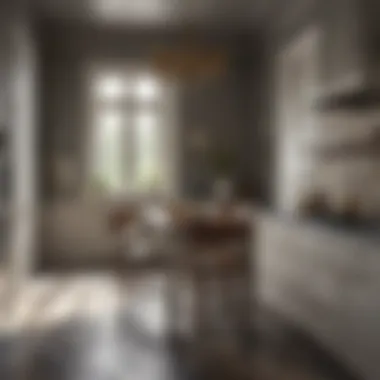
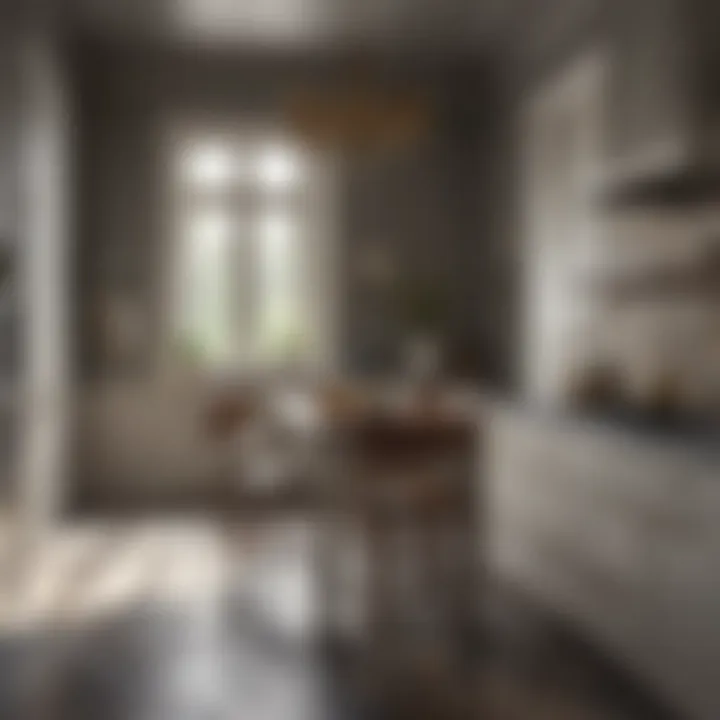
Sustainability is no longer just a buzzword tossed around in design circles; it has transformed into a guiding principle that shapes our living spaces, particularly in kitchens and bathrooms. These areas of a home, known for their heavy use and impact on household resources, require thoughtful decisions that prioritize environmental stewardship without compromising style or functionality. Focusing on eco-friendly materials, water conservation, and energy-efficient appliances, sustainable practices elevate both the aesthetics and ethics of design, demonstrating that home improvement can contribute positively to the planet.
Eco-Friendly Materials
Recycled Products
Recycled products are gaining traction in kitchen and bath design, offering both sustainability and uniqueness. These materials come from repurposed sources that minimize waste while delivering a distinctive appearance. For instance, countertops made of recycled glass or tiles crafted from reclaimed wood bring character to spaces, becoming conversation pieces. The key characteristic of recycled materials plays well into the current trend towards sustainability; they signify conscious consumerism.
One big advantage here is the reduced environmental footprint, which sometimes translates into cost savings for homeowners in the long run. However, it’s worth noting that the availability and maintenance of these products might require careful planning.
Sustainable Woods
When considering sustainability in the kitchen or bath, sustainable woods are some of the most appealing options. Sourced from responsibly managed forests, these materials not only look fantastic but also carry a lower environmental impact. The key characteristic here is durability—woods like bamboo or reclaimed timber not only provide warmth and organic beauty to spaces but also stand the test of time.
A unique feature of sustainable woods is their ability to resist wear and tear, making them a smart investment. However, they can come with a higher price tag, which could be a consideration for budget-conscious homeowners.
Low-VOC Paints
Low-VOC paints are another vital aspect of creating sustainable kitchens and bathrooms. VOC, or volatile organic compounds, are chemicals that can harm indoor air quality. By choosing low-VOC options, homeowners ensure healthier living conditions, while infusing spaces with color. The most important attribute of these paints is their ability to still deliver high-quality finishes without off-gassing harmful toxins.
These paints offer rich color palettes and a wide range of choices, catering to diverse design preferences. The downside? Some may require longer drying times or multiple coats for complete coverage, but many find the trade-off worth it for the sake of health and environmental responsibility.
Water Conservation Strategies
Smart Fixtures
Smart fixtures are revolutionizing the way we think about water use in kitchens and bathrooms. These technologically advanced products help monitor and manage water flow, allowing households to save significant amounts of water without sacrificing functionality. The key characteristic of smart fixtures is their intuitive design, which can automate water usage in response to user needs. One powerful advantage is the integration with apps that provide data about water consumption—which not only alerts users when they’re using too much but helps track habits over time. A potential downside could be the initial investment cost, yet many are swayed by the subsequent savings and ease of use.
Rainwater Harvesting
Rainwater harvesting is an innovative method that can contribute significantly to water conservation efforts in home design. By collecting rainwater, homeowners can use it for irrigation, flushing toilets, or even washing clothes. The critical advantage is that it reduces reliance on municipal water supply, proving helpful especially in areas experiencing water scarcity.
It's a more involved system requiring proper installation and maintenance, but it can offer a sustainable solution that many view as a valuable addition to their homes.
Greywater Systems
Greywater systems are an advanced solution aimed at maximizing water reuse. This system involves capturing water from non-potable sources, such as sinks and showers, before directing it to be used for irrigation. The key aspect of greywater systems lies in their ability to recycle water, creating a highly sustainable cycle.
Homeowners appreciate that these systems can significantly lower water bills while promoting a greener lifestyle. However, installation and local regulations can complicate things, leading some to hesitate before committing.
Energy-Efficient Appliances
Energy Star Ratings
Energy Star ratings are an important benchmark when selecting appliances for kitchens and baths. These appliances have been certified to use less energy, thus reducing a household's carbon footprint. The key feature of Energy Star appliances is their quality and efficiency, reassuring buyers that they are making responsible choices.
A notable advantage is savings on energy bills, over time, these investments can pay for themselves. The only drawback might be the upfront cost, as higher efficiency tends to come with a higher price tag.
Smart Home Integration
Smart home integration is taking kitchen and bath design to the next level. Using technology to monitor and control everything from lighting to temperature, homeowners can create highly functional spaces that align with their lifestyles. The essential characteristic of these systems is their adaptability to user preferences, offering a streamlined approach to energy use.
One key benefit is enhanced convenience and efficiency, significantly cutting down on energy consumption. Yet, the complexity of installation or potential tech malfunctions could be a concern for less tech-savvy homeowners.
Upcycling Old Appliances
Finally, upcycling old appliances speaks volumes about sustainability in design. Rather than discarding outdated or non-functional items, homeowners are increasingly looking to repurpose them, turning them into unique decor or functional components. The core idea is to breathe new life into what might otherwise become waste.
The beauty of this practice lies in creativity and innovation; for example, transforming an old sink into a stylish coffee table can add character to any space. However, it does require a certain level of crafty skill and imagination, which may not be everyone's forte.
Sustainable practices in kitchen and bath design reflect a commitment not only to aesthetics but also to responsible living.
Incorporating Personal Style
When it comes to kitchen and bath design, injecting your personal style can make all the difference. This dimension transcends mere aesthetics; it transforms spaces into reflections of individual choices and lifestyles. When homeowners weave their distinct preferences into their design decisions, they not only cultivate an attractive environment but also create a residence that tells their story, enhancing the emotional resonance of the home.
Incorporating personal style involves considering multiple elements from accessories to color schemes. It’s about choosing pieces that resonate with your self-identity while balancing functionality. This fusion may provide a unique ambiance or warming familiarity, striking a harmony between usability and personal expression.
Selecting Accessories and Accents
Art and Decor
Art and decor are not just about making a space look good; they evoke feelings and memories. When chosen thoughtfully, artworks can have a central role in establishing a mood or theme in kitchens or bathrooms. For instance, a vibrant painting can serve as a striking focal point, drawing the eye and sparking conversation among guests.
A key trait of art and decor is their versatility. From abstract pieces to vintage prints, the possibilities are nearly endless. Choosing art that reflects personal tastes allows homeowners to express themselves uniquely. One can incorporate local artists, or family heirloom pieces, enhancing not only style but also sentimentality.
However, a consideration is practicality. In high-moisture areas like kitchens and baths, certain artworks might require protection from humidity. Thus, selecting items that are both beautiful and resilient is crucial.
Textiles and Patterns
Textiles and patterns can inject warmth and comfort into kitchen and bath spaces. Cushions, rugs, or even shower curtains with bold patterns can create a lively atmosphere, striking a balance between energy and tranquility. A popular choice of materials includes cotton or linen that is easy to maintain yet visually appealing.
The distinctiveness of textiles lies in their ability to change the mood as easily as flipping a switch. One week, a bright floral pattern can breathe life into the space, and the next, a minimalist geometric pattern can promote serenity.
Nevertheless, there's a pain point in selecting textiles. Some materials may not be as durable or easy to clean, which can become a hassle over time. So, aligning style with practical upkeep is essential in keeping things looking fresh.
Functional Accessories
Functional accessories play a dual role; they enhance efficiency while also complementing the decor. High-quality kitchen tools or stylish bathroom storage options can translate into a blend of style and practicality. For instance, a uniquely designed soap dispenser can act as an eye-catching centerpiece, adding a touch of elegance to the mundane.
These accessories often come in a variety of materials and designs that can harmonize with existing decor choices. When selected wisely, functional pieces don’t just serve a purpose but also embody the homeowner's style preference.
However, it's essential to strike a balance when choosing functionality alongside elegance. Some items might prioritize aesthetics at the expense of usability, leading to frustration. Therefore, selection should focus on features that equally serve both functions.
Creating a Cohesive Look
Color Coordination
Color coordination is fundamental in creating a seamless and inviting environment. It allows different elements within a kitchen or bath design to interact harmoniously, creating a unified appearance. Choosing a palette that resonates with personal style helps the space to feel intentional and organized.
A significant aspect of effective color coordination involves understanding color psychology. Soft blues can promote calmness, while vibrant yellows may evoke energy. This relationship makes it vital to pick colors that not only look good together but also reflect the desired atmosphere.
On the downside, one possible disadvantage may be the risk of limiting choices based solely on favored hues. A rigid adherence to a color scheme can lead to a space feeling stagnant over time.
Consistent Materials
Utilizing consistent materials enhances continuity in design and promotes a more polished look. Using the same types of materials, whether wood, stone, or metal, ensures that the kitchen and bath feel cohesive. For instance, carrying the same countertop material from one space to another fosters an uninterrupted flow.
The major advantage of this approach is that it creates a harmonious balance, often elevating both areas without the need for extensive decor efforts. Furthermore, certain materials may age gracefully, adding character over time while sustaining an attractive ambiance.
However, it’s worth noting that consistency might also constrain creativity. Homeowners must ensure that while materials complement each other, they shouldn't limit personal flair or expression, which is crucial in achieving a truly personal design.
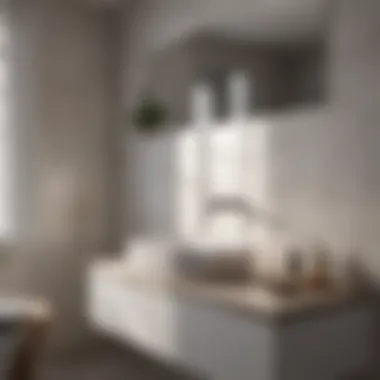
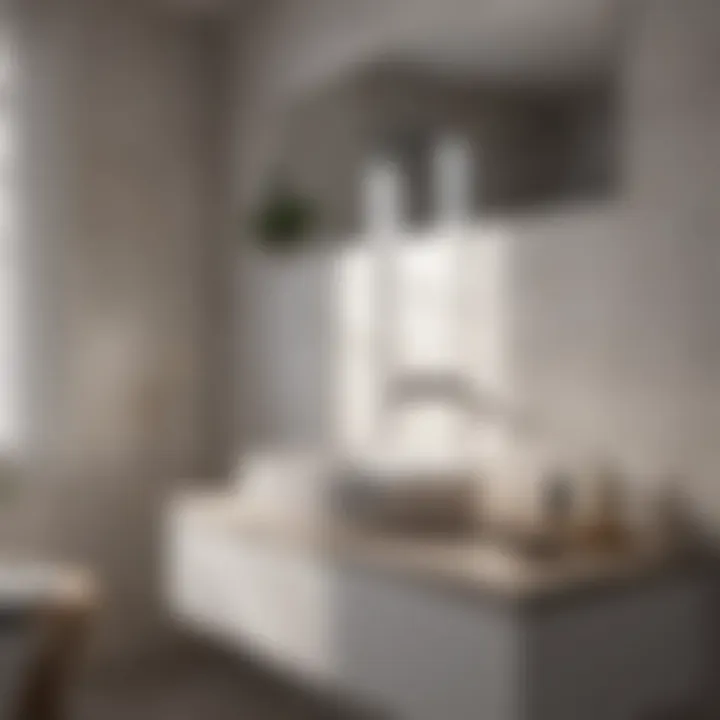
Vision Boards
Vision boards are an instrumental tool that helps visualize personal style and preferences, creating connections between various elements. Collecting images, textures, colors, or even materials can provide inspiration, steering the homeowner toward making informed decisions.
One key feature of vision boards is that they foster a comprehensive understanding of how different design components can interact. Looking at the collected pieces can reveal personal trends and highlight preferences that might not have been immediately apparent.
Nevertheless, it’s easy for vision boards to become overwhelming. A mishmash of ideas could lead to confusion in the actual design process. Balancing creativity with a focused approach is necessary to avoid that pitfall while still nurturing personal style.
Balancing Trends with Timelessness
Integrating Modern Trends
Integrating modern trends allows homeowners to stay updated while adding a personal touch to their design. Trends can often breathe fresh air into a space, introducing exciting colors or innovative features. For instance, open shelving in kitchens can showcase personal dishware while adding a modern twist to traditional layouts.
The advantage of weaving in trends lies in the lively nature they bring, helping create evocative spaces that speak to contemporary norms. They provide opportunities for homeowners to express their evolving tastes in a manner that’s distinctively modern.
On the flip side, trends can be fleeting. Aesthetic choices that seem exciting today may appear outdated in years to come, potentially impacting longevity in design. Thus, combining trends with classic elements can dilute the risk of becoming quickly dated.
Recognizing Fading Styles
Being aware of fading styles is integral to successfully crafting a space that remains relevant over time. Trends that once garnered significant attention sometimes become forgettable. Recognizing these shifts allows homeowners to preserve their design without compromising on personal style.
A key characteristic of recognizing fading styles is the skill to discern what trends have longevity versus those teetering on the edge of obsolescence. This knowledge enables homeowners to invest in elements that have the potential to endure.
Not recognizing falling trends can lead to investing in items that quickly lose their appeal. This lack of foresight may result in added expenses for replacements sooner rather than later, which is something to definitely consider in the design journey.
Timeless versus Trendy Choices
Understanding the difference between timeless and trendy choices is essential for anyone interested in kitchen and bath design. Timeless choices can maintain their appeal for years, such as classic subway tiles or rich wood cabinetry, while trendy choices may need to be re-evaluated more frequently.
The beauty of timeless design lies in its ability to blend well with various styles and periods, creating spaces that feel ageless. Choosing these elements fosters a sense of durability and grace.
However, the challenge with only selecting timeless pieces is that it can sometimes feel static or bland. A spritz of trendy elements can invigorate the space and make it feel more personal. Hence, balancing both can lead to a design that feels both classic and contemporary.
Maintenance and Longevity of Designs
In the realm of kitchen and bath design, focusing on maintenance and longevity is not merely a nice-to-have; it's a necessity. The appeal of these spaces often diminishes over time without proper care, transforming what was once a serene environment into a neglected corner of the home. By paying attention to maintenance practices and design longevity, homeowners can not only retain but also enhance the beauty and functionality of their kitchens and bathrooms.
Investing time and effort into maintenance can result in reduced costs over time and prolong the life of fixtures and features. A well-maintained space is more than aesthetically pleasing; it’s also a smart financial decision. With an eye on sustainability, vital choices can be made that positively affect the environment while ensuring a timeless quality.
Routine Maintenance Tips
Cleaning Techniques
Keeping surfaces clean is the first line of defense against wear and tear. Different materials require unique cleaning approaches. For instance, natural stone countertops need gentle, pH-balanced cleaners to avoid etching, while stainless steel demands a straightforward wipe-down and a bit of polish for that shiny finish.
The key characteristic of effective cleaning techniques lies in the details; they should not just clean but also prevent the buildup of grime and longer-term damage. An effective strategy might involve routine deep cleanings using non-abrasive products, which help retain the original luster of surfaces.
While many opt for chemical-laden products, green cleaning solutions can be just as effective while being kinder to the environment. The downside, however, is that sometimes heavier stains might require alternative methods which could be less eco-friendly - a balancing act.
Preventive Care
This facet of maintenance could involve regular checks of plumbing fixtures, sealants around sinks, and caulking in showers. Preventive care isn’t just a fancy term for keeping things clean; it’s about anticipating future issues before they blossom into major problems. Small leaks left unchecked can lead to bigger water damage down the line, making this care a wise practice.
Notably, preventive care shines during seasonal maintenance checks. Implementing a routine inspection schedule can keep things running smoothly. Homeowners might find that this practice saves them money in the long run, but it can be time-consuming to stay consistent.
Seasonal Inspections
Routine inspections every season help bridge the gap between cleaning and preventive care. Checking for mold, ensuring that caulking stays intact, and examining fixtures can spotlight potential trouble areas. This process contributes significantly to maintaining the integrity of both kitchens and bathrooms.
A highlight of seasonal inspections is their timing; they remind homeowners to take stock of their spaces before major issues emerge. The challenge lies in the fact that many often overlook this crucial aspect during busy months, resulting in disparities in maintenance.
Addressing Repairs and Upgrades
Catching Issues Early
The moment a small problem surfaces – say, a loose faucet or a slight dribble in the bathtub – it's pivotal to address it right away. Catching issues early can prevent them from escalating into bigger headaches later. Regular monitoring and observant eye can be game changers in this respect.
The benefit of this early intervention is clear: it saves cost and effort. However, it demands attentiveness and sometimes, an ounce of discomfort as certain repairs might require a bit of a hands-on approach.
Timely Upgrades
Timely upgrades can breathe new life into outdated designs. Investing in energy-efficient appliances can replace aging ones before they fail and also stand the test of time. Whether the focus is on aesthetics or functionality, knowing when to upgrade is an essential skill for homeowners.
The timely nature of this decision is beneficial in ensuring spaces remain fresh. However, the risk comes from investing in upgrades that may not provide long-term satisfaction if the choices lean too heavily into trends that fade.
Choosing Professional Help
There comes a time when a project just needs a professional's touch. Whether it's a plumbing issue or a complete remodel, knowing when to ask for help is vital. Choosing professional help can make the difference between a simple fix and a significant mess.
The key element here is expertise; professionals bring knowledge and experience that ensure work gets done correctly the first time. That said, this option might not be feasible for everyone, and finding trustworthy help can sometimes be challenging, leading to potential worry about the quality of the job.
Longevity Through Design Decisions
Resale Value
When it comes to kitchen and bath designs, decisions made today can impact resale value tomorrow. Potential buyers often appreciate timeless choices that resonate across various tastes. Opting for durable materials and classic features can greatly appeal to future purchasers.
The appeal of maintaining resale value presents a strong case; home renovations that stand the test of time often return a solid investment. However, homeowners have to balance personal preferences with market expectations, which can at times lead to indecision.
Adapting Spaces Over Time
Flexibility in design allows spaces to adapt to changing lifestyles and needs. An open layout, for instance, can be more accommodating and versatile as families grow or change. It’s essential for designs to cater not only to present needs but also to foresee future requirements.
The benefit of adopting a design mindset focused on adaptability is clear. It encourages homeowners to think creatively about their spaces. Yet, this can be a bit of a balancing act, as one must consider potential changes while still establishing a cohesive feel in the current setup.
Neutral Choices for Future Appeal
Using neutrals can help create a canvas for future personalization while maintaining broad appeal. Colors, patterns, and finishes that are too bold might feel dated sooner rather than later. By opting for softer colors or classic designs, homeowners keep their options open for future decor.
This choice supports the benefit of longevity; the flexibility to accentuate a space’s style without needing a massive overhaul. However, it’s important to be careful not to choose neutrals that may come across as too bland or lifeless, potentially leading to a space that lacks character altogether.















